Customer retention: A guide from a VP of Customer Experience

VP of Customer Experience

Tags
Share
Whether you’re running an ecommerce company, a tech startup, or a service-based business, retaining customers is one of the most important things you have to do (other than winning new customers).
It’s more cost-effective than winning new customers, for one (a quick Google search will pull up no shortage of statistics and research supporting this), and often, it’s also easier to do than winning new customers.
It’s also great for your bottom line. So, how can you keep customers happy, build brand loyalty, and keep them around longer?
Having worked as a leader in customer experience for many years, I’ve seen a lot of companies rely heavily on tactics like gifting and rewards programs. While these can work, they shouldn’t be the core of your customer retention strategy.
In this guide, I’ll walk you through why that is, and a few alternative options that I believe are just as—if not more—important when it comes to customer engagement.
What is customer retention?
Let’s start with a quick recap of the basics: What is customer retention? Essentially, customer retention refers to keeping your existing customer base from churning (leaving you). Often, the best way to do this is to not just meet customer expectations, but exceed them.
I’ll show you how to calculate customer retention rate in just a bit, but what’s important to remember here is that retention isn’t just one step in the late stages of your customer journey. If you approach like that, you’ll likely fall into the trap of thinking that customer loyalty programs and a few small gifts here and there will be all you need.
That isn’t true.
Customer engagement should be part of a holistic strategy—and to truly do retention well, you should be planning for it from the very early stages of your customer journey.
Why is customer retention important?
As any CX leader knows, customer retention is important because it's one of the best things you can do for your business' growth and bottom line. Keeping customers around costs less than winning new customers (seriously, there is no shortage of studies and statistics out there)—and the more customers you don't retain, the harder your marketing and sales teams have to work to make up for that gap in paying customers.
If you can increase the length of your customer relationships, it'll go a long way in helping your business direct its spend to more impactful initiatives instead of constantly being on the hamster wheel of earning new customers just to stay afloat.
Before we get into customer retention strategies, let’s talk about some common mistakes that companies make.
Common customer retention mistakes to avoid
Over-relying on customer loyalty programs and rewards
Since they’re one of the most common customer retention examples, I’m going to get this one out of the way first.
To be clear, I’m not saying that loyalty programs are bad in and of themselves. In fact, they can be very useful for customer retention in certain situations.
But they cannot make up for other deficiencies in your customer journey. If your product is not good, or if you have poor customer support, or if your app has a terrible user experience, even the most generous rewards won’t help you earn loyal customers.
Amazon has so many repeat customers because every step of the customer journey is designed well and it has a good customer experience—not because it gives a ton of rewards to current customers.
Not ensuring alignment between your products or services and customers’ needs
If you’re selling something that you think customers want, but not actually asking them whether they want it, that can be a fatal mistake for a business.
The best way to avoid this is to regularly survey your existing customers (it can be part of your email marketing program or you can just call them if you have a smaller number of customers) to ask them directly. “Are our products or services delivering what you need?”
Yes, you may get hard feedback, but it’s the best way to truly understand customer behavior and whether you’re meeting your customers’ expectations.
(It’s also a great way to gather testimonials for your website, which will help you attract a larger number of new customers.)
👉 Dialpad tip:
If you have different customer personas, you should be aware that they may be looking for different things from your products or services—which means “alignment” will look different depending on which customers you’re talking to.
Not communicating regularly with customers
On a related note, you should be communicating with your customers at regular intervals. Ideally, you’d have a good understanding of your customer lifecycle.
To that end, it’s a great idea to make sure customers are told about your innovations and new products. They already like your company enough to have shopped with you in the past, so chances are, they’ll be interested in fresh opportunities to shop with you too.
Personalization is a lifesaver when it comes to advertising to existing customers. That’s why it’s an essential part of the digital customer experience and should always be included in retention processes.
Not only does it help increase customer retention, it can also provide valuable insights for, say, your marketing strategy.
👉 Dialpad tip:
Be mindful of when you’re reaching out to customers for feedback. Generally, if you want feedback on your products, you should wait until a period of time has passed before asking. There’s no point asking for feedback or trying to upsell a new customer who hasn’t even had a chance to try your product yet. It’s a waste of both their time and yours.
Not involving your Product or Engineering team
The customer retention process is far-reaching in the sense that it isn’t just owned by your Customer Success or Customer Experience team. A successful customer retention strategy involves multiple departments.
That includes the Product or Engineering team that’s responsible for building new products and refining the products that you’re selling to your customers.
It’s crucial that they’re aware of customer feedback—otherwise, they won’t know what they need to fix. And if you’ve got “VIP” customers, you may want to consider giving them a direct line to your Product team so they can give feedback straight to them.
This is a great tactic because it makes customers feel important and can improve customer engagement. Of course, you have to be judicious. You can’t give every customer this access, and if a customer abuses this privilege, it hurts your team in the end. Be strategic with this one.
✨ UPLEVEL YOUR CUSTOMER EXPERIENCE
Grab the Contact Center Playbook, which breaks down everything you need to know, from setup to improving customer satisfaction—with examples from real contact center teams across different industries.
How to calculate customer retention rate (and improve it)
Now, let’s look at how to calculate your customer retention rate using a formula.
This one will show you your customer retention rate as a percentage. The higher your percentage, the more customers you’re retaining. Here's how to calculate your customer retention rate:
[(Customers at the end of a period - New customers) / Customers at the beginning] x 100
One thing to note: Customer retention rates will give you a snapshot of your retention over a certain period of time. If you look at the formula, you’ll notice that you need to define the start and end of the period. So, the best way to use this formula is to compare retention regularly, over similar periods of time.
Customer retention examples: The calculation in action
Let's run through a few examples using that calculation above.
Let's say your customer support or customer success team is doing alright—your business ended with 200 customers, added 50 new customers, and started with 180 customers:
[(200 - 50) / 180] x 100 = 83.33%
Your customer retention rate here is 83.33%.
What if you have a global enterprise with a much larger number of customers?
[(50000 - 10000) / 45000] x 100 = 88.88%
Other customer retention metrics to be aware of
Beyond customer retention rate, there are a few other KPIs (key performance indicators) and metrics that may be useful as you work toward earning loyal customers.
Here are a few.
Customer churn rate
Customer churn describes the rate at which customers leave your business, whether they decide to go to your competitors or simply stop buying from you. Churn is the opposite of customer retention.
Often, your customer churn rate is closely tied to your customer satisfaction. Churn is extremely important because it negates any good work you do on the customer acquisition side. You’re working hard to win new customers—but if they churn at a very high rate, all the money you spent on winning them will have been wasted.
👉 Dialpad tip:
In SaaS (Software as a Service) companies, there’s often a Customer Success team that’s solely devoted to making customers successful with your product. That includes helping new customers with onboarding, learning how to use the product, and so on—but the end goal is, well, customer success. The thinking here being: If the customer is successful because of your product, they’ll stick with you longer. These teams are key to reducing churn rates.
Net promoter score
Your Net Promoter Score (NPS) is another key metric to look at for customer retention. It’s essentially a measurement of whether your existing customers will promote you, whether it’s through social media or word-of-mouth.
One important thing to note about NPS is that it gives you a quantitative estimate of how likely you are to get referrals from customers. It’s best if you can get qualitative customer feedback as a complement so that you can have a more holistic view.
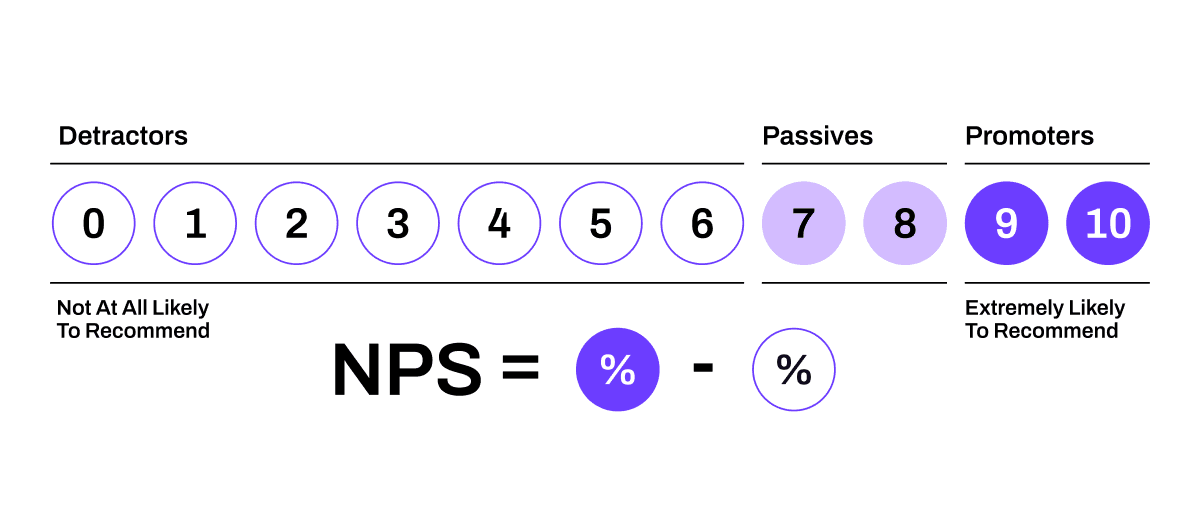
Your NPS score is a reflection of the quality of your customer relationships, and the higher your score, the better.
Customer lifetime value
Some customers choose to make one purchase with you, while other customers have a long lifecycle with your company and stay with you well beyond their first purchase.
It’s important to understand your customers’ lifetime value because it gives you a long-term view of the value of that customer relationship. It takes into account how many times they’ve bought from you and how much they’ve spent—a bottle of Coke might be only two or three dollars, but over the lifetime of a customer who drinks Coke regularly, that might end up being thousands or even tens of thousands of dollars in customer lifetime value.
Your customer lifetime values are correlated to your customer retention because customer acquisition and retention are investments—and customers with high CLVs pay that investment back more with each month or year that goes by.
*Repeat purchase rate
This metric is mainly for ecommerce or service-based businesses like an accounting firm that can have repeat customers or clients. If you’re a software company like Dialpad, for instance, you’d be looking at renewals, not repeat purchases.
The first time a new customer buys from you is a great milestone, but ideally, you’d want them to follow up with repeat purchases later.
The more repeat purchases a customer makes, the higher their CLV.
4 customer retention strategies: From basic to advanced
A good customer retention strategy should contain a few different tactics. (For example, you shouldn’t just be doing a single thing to improve retention—and if you are doing just a single thing, that thing definitely shouldn’t be a gifting or rewards program.)
Below, I’ll walk you through a few customer retention strategies, from more simple strategies to more advanced ones. We’ll be looking at some case studies as well, so you can see firsthand how these tactics work in practice.
1. Respond to customer calls and emails in a timely manner
This is as basic and straightforward as it gets. If you want to keep your existing customers around, you have to be responsive when they contact you with issues or questions.
And yet, many companies don’t do this.
Riders Share, a smaller company that calls itself the “Airbnb of motorcycles,” has a small contact center team to respond to customer questions. Even its CEO, Guillermo, helps with customer support. But even with a small team, they’re a perfect case study in how it’s possible to respond to customers quickly if you have the right software.
Customers are so impressed when we’re on a call and I message them the website link they need—usually before they’re even done asking the question! And if I have a missed phone call, I can text them right back.
Guillermo Cornejo
CEO, Riders Share
How does he do it? Riders Share doesn’t have a business phone system—they use Dialpad as their unified communications platform, which means they can not only make phone calls, but also have video meetings and send SMS/MMS and team messages from a single desktop or mobile app:
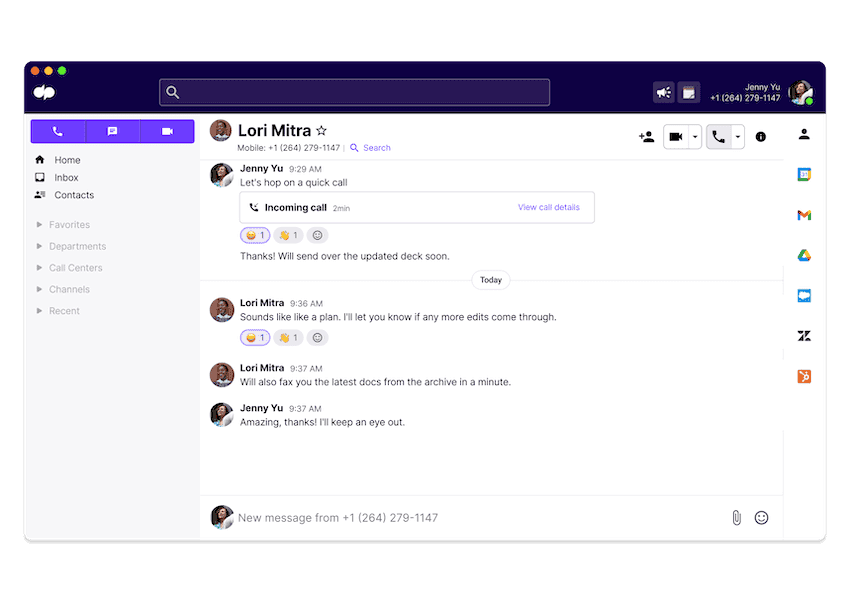
Not only that, Dialpad also has built-in AI functionality that can transcribe calls (in real time), track common topics or keywords, and more. Most importantly, it streamlines all those workflows and communications into one convenient place.
The result? Even a small customer support team can make huge strides in retaining customers.
2. Make customers feel included and engaged
I mentioned this earlier, but making customers feel included can be a huge part of a successful customer retention strategy.
Other than involving customers with product feedback and giving them access to your Engineering or Product team, this could also be as simple as doing a short survey during customer onboarding to see how they’re finding the process.
Or, you could do a CSAT (customer satisfaction) survey. Dialpad Support, for instance, comes with a CSAT feature that lets you easily set up the survey with a few clicks:
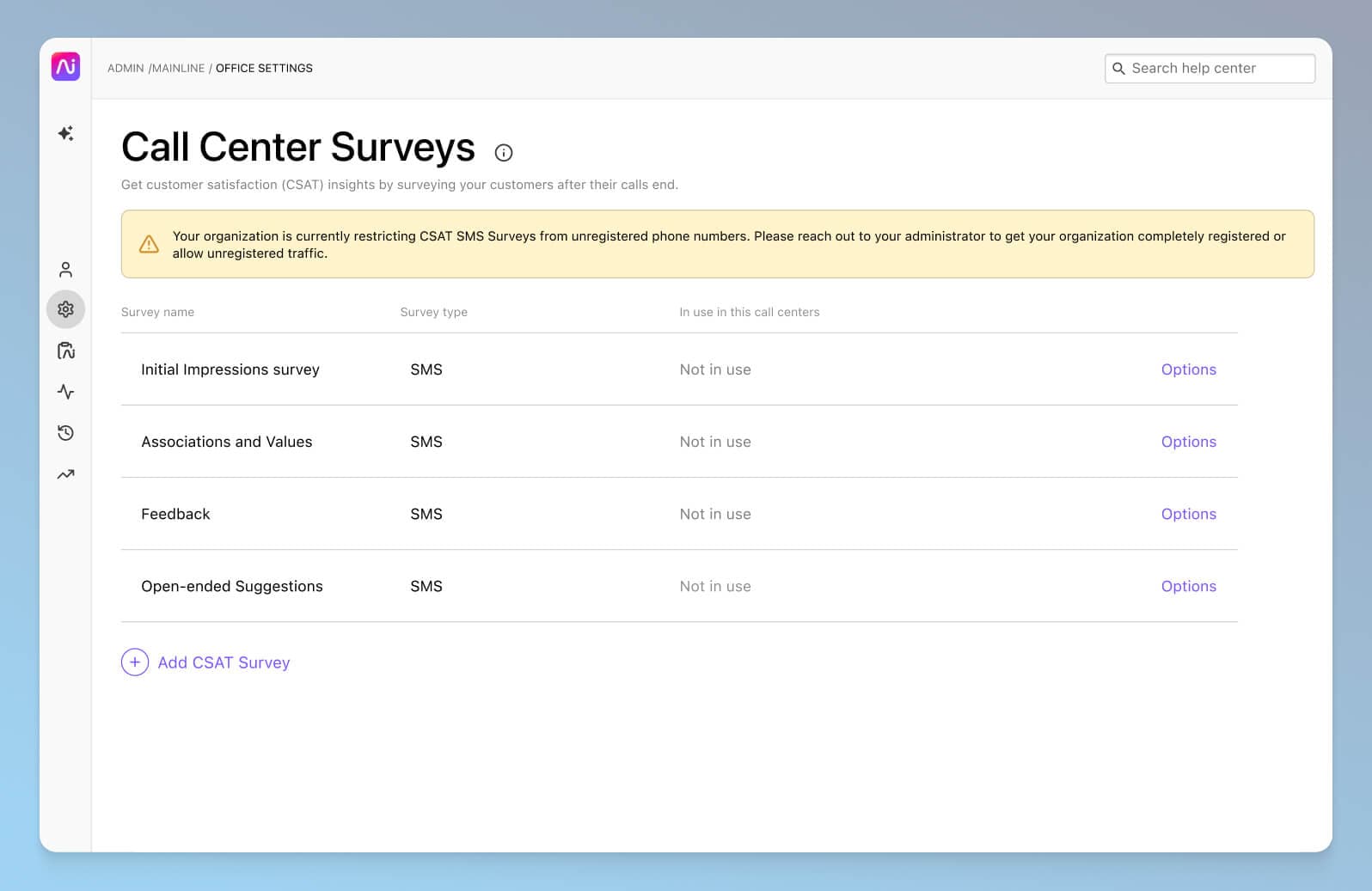
Once it’s set up, the survey will automatically play after a call to gather that customer feedback for you.
3. Use analytics and data to optimize customer retention
This strategy is a little more complex. Collecting data is one thing. Using those metrics to improve your customer experience and strategy is another.
One key thing to note is you should be monitoring your analytics regularly. It’s not a one-off project, and to consistently increase customer retention, you need to have a long-term plan.
Central Restaurant Products, for example, uses analytics in a few ways. With Dialpad as their communications and contact center platform, they can see metrics like call volumes and average speed to answer:
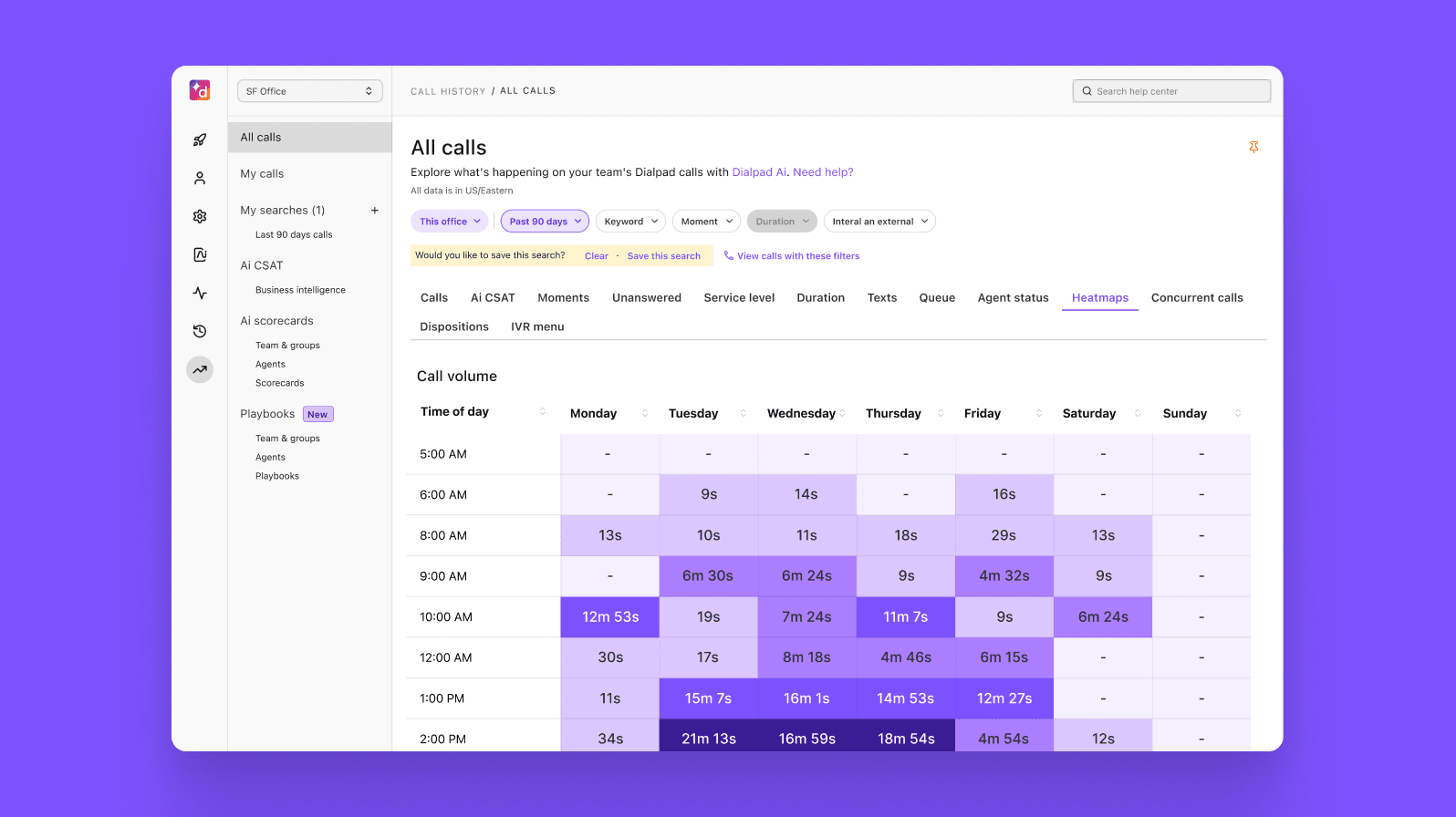
The heat maps allow us to look at when calls are being made and received, which allows us to make sure that we have the right people in the call center.
Nat Norris
VP of Marketing and IT, Central Restaurant Products
Besides this, Nat’s teams also use Dialpad’s Salesforce integration (Dialpad has a range of CRM integrations including HubSpot and Zoho CRM as well) to log customer relationships and interactions in one place:
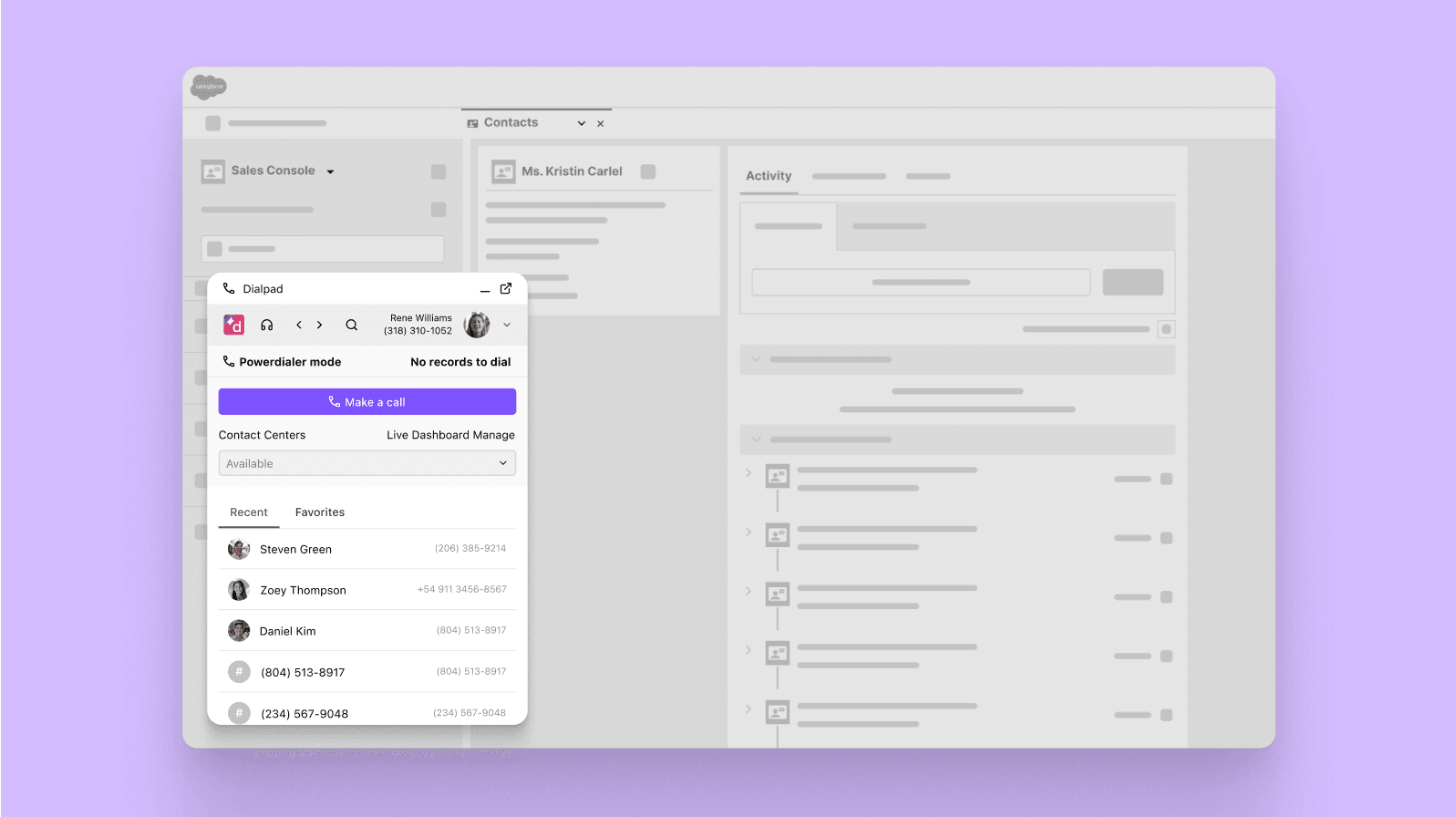
If you can staff properly and make sure you have enough people handling customer questions, it can go a long way in helping your agents focus on resolving issues effectively. A customer service scorecard is also an effective method of empowering agents to deliver superior service.
Dialpad's AI-powered customer engagement platform has a range of AI-powered automations that help with this. One is the RTA (Real-time Assist) cards. Managers can create RTA cards with tailored notes on tricky topics, and set them to trigger automatically on agent's’ screens when those keywords are spoken on calls:
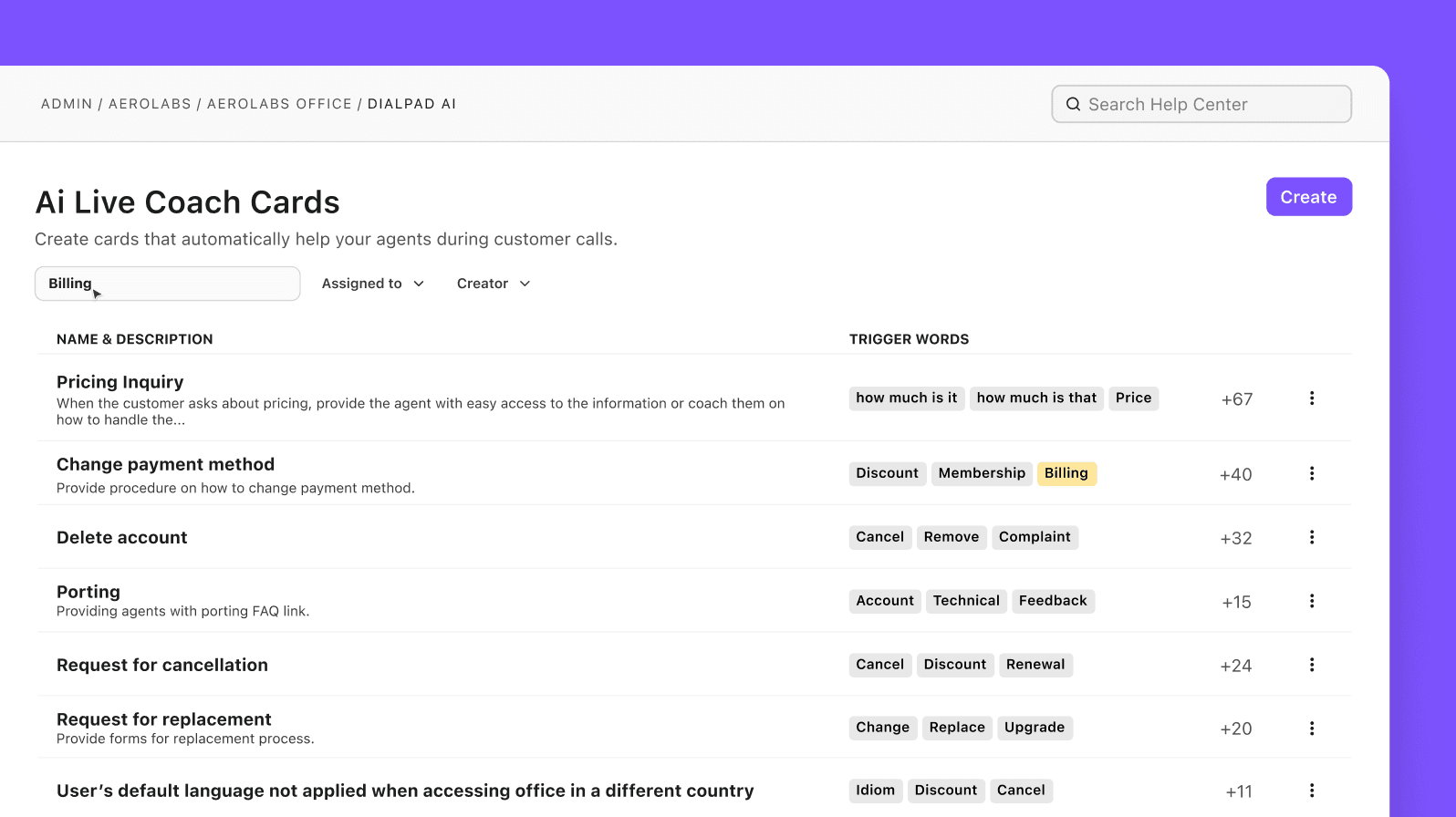
This way, supervisors don’t have to personally coach every single call, but customer support agents can still get the information they need.
4. Have a thoughtful customer retention program
This seems like an obvious one, but building a thoughtful retention program can be one of the hardest things to do.
Not only do you have to be familiar with your whole customer journey, you also have to deeply understand what customers want—and what drives them away. Only with this information can you create effective tactics to sustainably retain customers over a long period of time.
For example:
Seeing that lots of customers churn about a week after onboarding, and offering a gift to try to win them back. Not thoughtful.
Seeing that lots of customers churn about a week after onboarding, and setting up a survey as part of their onboarding process to better understand what they need to get started and what questions they may have. That’s a little bit better.
What is a customer retention program?
A customer retention program is a holistic strategy that usually contains a few customer retention tactics that complement each other. For example, you might combine a loyalty program with regular surveys to understand customer needs, and the more that customers engage with these surveys, the more “points” they earn.
Think beyond the basic loyalty schemes that businesses try to pass off as customer retention programs. What incentives do your customers need? If they really just want points, tokens, vouchers, or coupon codes, then sure, make that a part of your retention program.
But most customers aren’t slot machines. They’re humans who come to you with specific needs in mind, who understand that bugs or mistakes happen from time to time, and who are often loyal without the need for a “loyalty program.”
Ready to improve your retention rate with the right customer retention software?
Beyond just providing good customer service, retention requires work in many other areas.
From the initial onboarding experience, to your customer support, to refining your online checkout process, there are many, many ways to influence customer retention.
Use different combinations of the tactics I mentioned above, and try others that I haven’t, to find the right mix for your particular business or industry.
And if you need a good contact center platform that lets your team work from anywhere while handling all your customer communications across digital, voice, and video channels, why not check out Dialpad Support?
Not only does it let you have phone calls, video meetings, and messaging all in one place, it also has unique AI features that are designed to make life easier for agents and supervisors.
See how Dialpad can help you increase customer retention!
Book a demo and we'll walk you through how it can empower your agents and supervisors to retain more customers. Or, take a self-guided interactive tour of the app on your own first!
